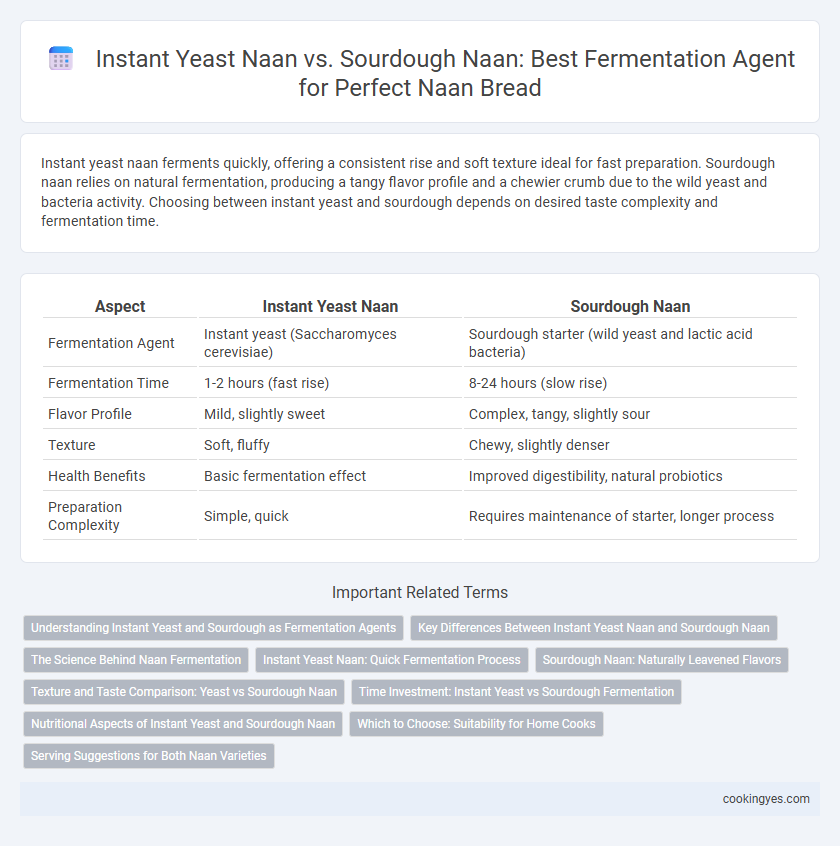Instant yeast naan ferments quickly, offering a consistent rise and soft texture ideal for fast preparation. Sourdough naan relies on natural fermentation, producing a tangy flavor profile and a chewier crumb due to the wild yeast and bacteria activity. Choosing between instant yeast and sourdough depends on desired taste complexity and fermentation time.
Table of Comparison
| Aspect | Instant Yeast Naan | Sourdough Naan |
|---|---|---|
| Fermentation Agent | Instant yeast (Saccharomyces cerevisiae) | Sourdough starter (wild yeast and lactic acid bacteria) |
| Fermentation Time | 1-2 hours (fast rise) | 8-24 hours (slow rise) |
| Flavor Profile | Mild, slightly sweet | Complex, tangy, slightly sour |
| Texture | Soft, fluffy | Chewy, slightly denser |
| Health Benefits | Basic fermentation effect | Improved digestibility, natural probiotics |
| Preparation Complexity | Simple, quick | Requires maintenance of starter, longer process |
Understanding Instant Yeast and Sourdough as Fermentation Agents
Instant yeast naan uses commercial Saccharomyces cerevisiae yeast, providing rapid fermentation with consistent dough rise and a soft texture. Sourdough naan relies on natural wild yeast and lactic acid bacteria from a fermented starter, creating a complex flavor profile and longer fermentation time. Both fermentation agents influence naan's taste, texture, and fermentation speed, with instant yeast favoring convenience and sourdough emphasizing artisanal qualities.
Key Differences Between Instant Yeast Naan and Sourdough Naan
Instant yeast naan uses commercial yeast for rapid fermentation, resulting in a softer texture and quicker preparation time compared to sourdough naan. Sourdough naan relies on natural wild yeast and bacteria, producing a more complex flavor profile with a slightly tangy taste and chewier texture due to longer fermentation. The choice between instant yeast and sourdough affects fermentation duration, flavor depth, and nutritional benefits, with sourdough offering enhanced probiotics and digestibility.
The Science Behind Naan Fermentation
Instant yeast naan ferments quickly due to the rapid activity of Saccharomyces cerevisiae, producing carbon dioxide that creates a soft, airy texture within an hour. Sourdough naan relies on wild lactobacilli and naturally occurring yeast, resulting in a longer fermentation process that enhances flavor complexity and improves digestibility through organic acid production. The fermentation chemistry in sourdough also increases the bioavailability of nutrients by breaking down phytic acid, unlike instant yeast naan which prioritizes speed over depth of fermentation.
Instant Yeast Naan: Quick Fermentation Process
Instant yeast naan offers a rapid fermentation process, significantly reducing dough rising time compared to sourdough naan, which relies on natural lactobacilli and wild yeast fermentation. The use of instant yeast ensures consistent, predictable leavening and a soft, fluffy texture within minutes to an hour, whereas sourdough naan may require 8 to 24 hours for optimal fermentation. This quick fermentation enhances efficiency in commercial settings, maintaining flavor while saving preparation time.
Sourdough Naan: Naturally Leavened Flavors
Sourdough naan utilizes naturally occurring wild yeast and lactic acid bacteria for fermentation, resulting in complex, tangy flavors and enhanced digestibility. Unlike instant yeast naan, which relies on commercial baker's yeast for rapid rising, sourdough fermentation develops over a longer period, enriching the naan's texture and depth of taste. The slow fermentation process in sourdough naan also contributes to improved shelf life and a distinctive, artisanal character.
Texture and Taste Comparison: Yeast vs Sourdough Naan
Instant yeast naan develops a soft, fluffy texture with a mildly sweet and neutral flavor, providing a consistent rise and quick fermentation. Sourdough naan exhibits a chewier texture and tangy, complex taste due to wild yeast and lactobacilli fermentation, enhancing depth and aroma. The choice between instant yeast and sourdough significantly influences naan's crumb structure and flavor profile, catering to different culinary preferences.
Time Investment: Instant Yeast vs Sourdough Fermentation
Instant yeast naan requires only 1 to 2 hours of fermentation, enabling quicker preparation and baking, ideal for fast meal planning. Sourdough naan relies on natural wild yeast from a sourdough starter, demanding 8 to 24 hours of fermentation, which develops a deeper, tangier flavor through slow fermentation. The extended fermentation time of sourdough enhances nutrient absorption and texture but increases time investment compared to the rapid action of instant yeast.
Nutritional Aspects of Instant Yeast and Sourdough Naan
Instant yeast naan contains refined flour and commercial yeast, resulting in quicker fermentation but fewer nutrients and lower bioavailability of minerals. Sourdough naan undergoes natural fermentation with wild yeast and lactic acid bacteria, enhancing nutritional value by increasing vitamin B content, improving mineral absorption, and promoting gut health through probiotics. The extended fermentation process in sourdough naan also reduces phytic acid, which can inhibit the absorption of essential nutrients like iron and zinc.
Which to Choose: Suitability for Home Cooks
Instant yeast naan offers a quick and reliable rise, making it ideal for home cooks seeking convenience and consistent results without extensive fermentation time. Sourdough naan, while requiring longer fermentation and more skill, provides complex flavors and natural leavening favored by enthusiasts aiming for artisanal quality. For home cooks prioritizing ease and speed, instant yeast naan is typically more suitable, whereas sourdough naan suits those willing to invest time for deeper taste and texture.
Serving Suggestions for Both Naan Varieties
Instant yeast naan offers a soft texture and mild flavor ideal for quick meals, pairing well with curries, grilled meats, and dips like raita or chutney. Sourdough naan features a tangy profile due to natural fermentation, enhancing dishes such as spiced lentils, smoky tandoori chicken, and robust vegetable stews. Both varieties complement Indian and Middle Eastern cuisines, serving as versatile accompaniments for savory and spicy flavors.
Instant Yeast Naan vs Sourdough Naan for fermentation agent Infographic

 cookingyes.com
cookingyes.com